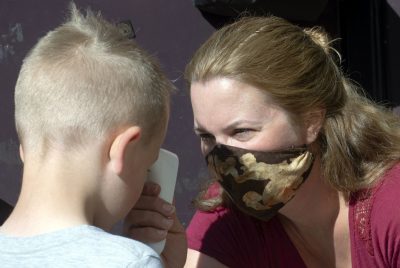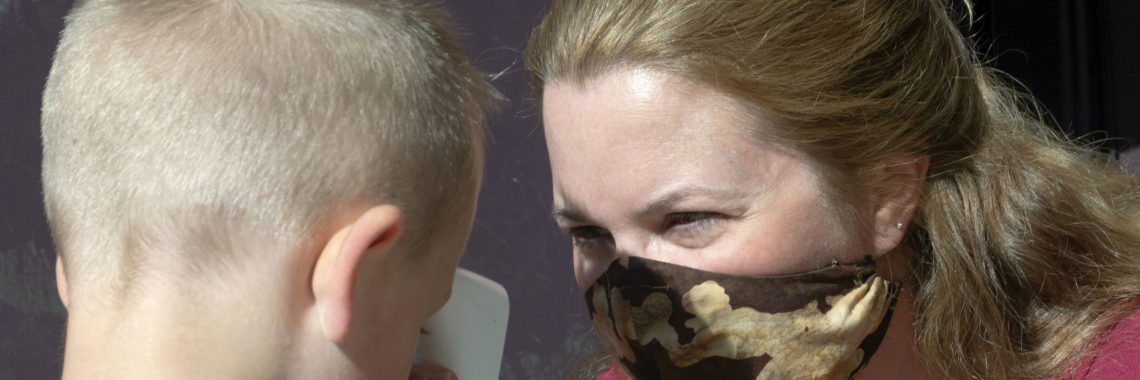
The Early Care and Education Center at the University of Wyoming was one of the earlier campus-based centers to reopen during the coronavirus pandemic even as some across the nation remain closed.
Parents, teachers and kids adapted to changes in the preschool environment. ECEC closed in March when COVID-19 hit and reopened May 26 for families that needed to get back to work. About 20 children came back at first, said Mark Bittner, ECEC director.
ECEC has been reaching out every two weeks to families who were contracted to come back for the summer. By June 15, all of the families planning to join this summer have arrived. The center has about 50 children now with normal occupancy around 85, said Bittner.
“We took it slowly,” said Bittner.
The ECEC is administered by the Department of Family and Consumer Sciences in the College of Agriculture and Natural Resources.
Katie Christensen and her husband were among one of the first families to send their child back to ECEC.
“It was really wonderful to have her go back and be social with other kids,” said Christensen. “That was one of the hardest parts of quarantine being that she is an only child. She just beamed when she got to see all of her friends.”
Christensen, who works as the curator of education with the UW Art Museum, explained she and her husband weren’t really sure what it would be like to go back with all the changes but said the center made it really easy.
“They not only have embraced the philosophy of the school but also the health and wellness of the kids, and I think it’s balanced really well,” said Christensen.
Christensen mentioned everyone’s circumstances are different regarding the need to send kids back to school and encourages everyone to do what’s best for them.
“We have no regrets sending her back to ECEC,” said Christensen. “Do what’s right for your own family, without judgment.”
The facility’s staff all tested negative when ECEC reopened in May. To open, disinfecting processes had to increase, which Bittner noted was easier to implement because teachers had already been doing this.
The issue Bittner came across was finding enough supplies and sanitation materials.
“We got some really good help from the Physical Plant on campus,” said Bittner. “They were able to get us more disinfects and really good hand sanitizer.”
Bittner’s next challenge was staffing. ECEC has six full time staff and the remaining staff members are college students.
“Once the university went all online for the rest of the spring semester, a lot of our staff went home,” said Bittner. “But I was able to convince 17 of our staff to stick around for the summer.”
Adina Bitner, a lead preschool teacher for the center, recalls the struggles of being home and constantly going through the what ifs of supplies and how to still create an inviting and welcoming environment for the kids.
“Coming back helped because we could just implement what we needed to do and if we needed to change it, we could change it,” said Bitner.
Bitner and other staff members are all required to wear masks. This required her to reconsider how that was going to change her teaching.
“Your losing half of your facial expression,” said Bitner. “As we read stories, give directions, how was that going to have to change because the mask changes what you sound like, and I had to remind myself to talk a little louder.”
Lesson plans are built around what materials could be cleaned and sanitized and how long it would take for those to dry.
“There are some materials that if we use them in the morning, that’s probably the only time, because they wouldn’t be dry quick enough, or it would take longer to clean,” said Bitner.
The center also had to change pick-up and drop-off procedures. Parents wait in the parking lot until a staff member can come get the kids, take their temperature and escort the kids into the building where they immediately wash their hands.
“I didn’t go into education thinking that this was something I’d ever deal with,” said Bitner.
Bitner noted the first few children who returned were initially excited to be back and see their friends again but after a few days, they began to have questions about other students who were not there and missing parents.
“It wasn’t a big stressor, but it was enough for us to talk about why these changes happened, and we talked about it frequently,” said Bitner.
Bitner said there have been many conversations with the kids about other kids who are not there, their feelings about missing their parents and home and reestablishing classroom expectations.
“That’s the nice thing about preschoolers,” said Bitner. “They are pretty willing to talk about things they don’t understand or things that are different.”
As more kids started to come back, Bitner noticed how the kids who had been there were able to help the new ones by explaining what was going on.
“There is a lot of empathy in that because they remember what it was like to come back,” said Bitner.
While the center has been successfully running through the summer, all involved still express concern for what will happen after Thanksgiving, with virtual classes starting and the possibility of college staff members leaving.
“There are so many unknowns right now that it’s challenging and unpredictable,” said Christensen. “But I also know that Mark and the whole crew are doing the best they can.”





